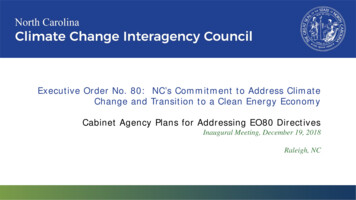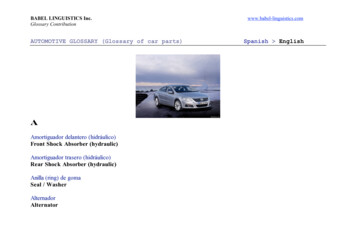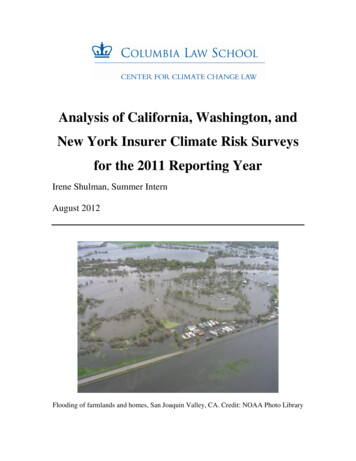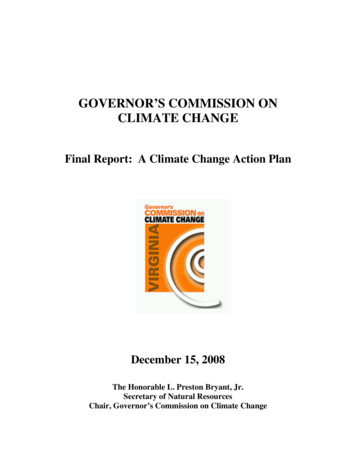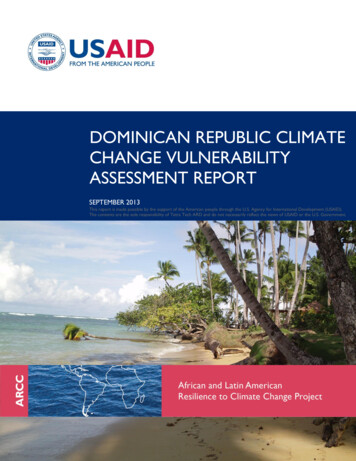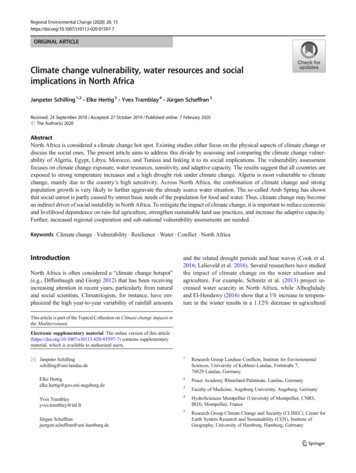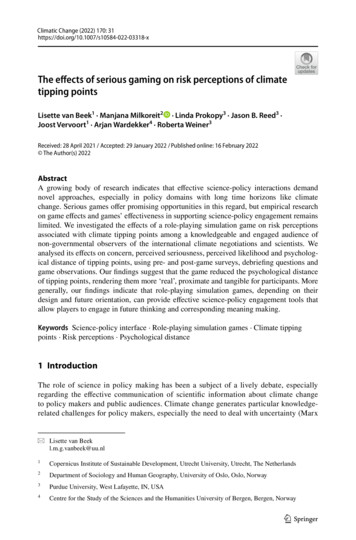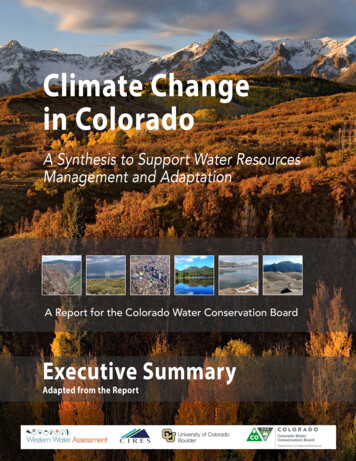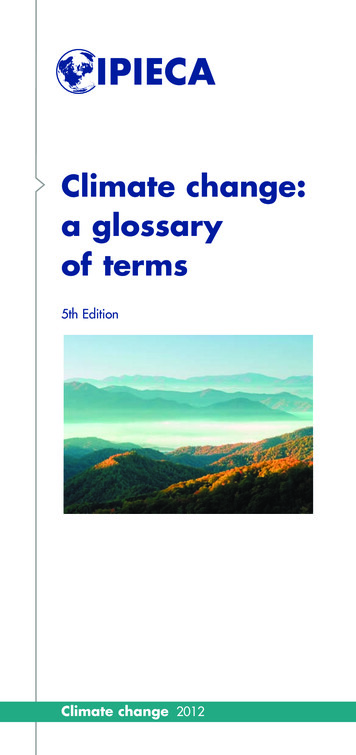
Transcription
Climate change:a glossaryof terms5th EditionClimate change 2012
The global oil and gas industry association forenvironmental and social issues5th Floor, 209–215 Blackfriars Road, London SE1 8NL, United KingdomTelephone: 44 (0)20 7633 2388 Facsimile: 44 (0)20 7633 2389E-mail: info@ipieca.org Internet: www.ipieca.org IPIECA 2012 All rights reserved.No part of this publication may be reproduced, stored in a retrievalsystem, or transmitted in any form or by any means, electronic,mechanical, photocopying, recording or otherwise, without the priorconsent of IPIECA.This publication is printed on paper manufactured from fibre obtainedfrom sustainably grown softwood forests and bleached without anydamage to the environment.
IPIECAClimate change:a glossaryof terms5th EditionPrefaceThe IPIECA glossary of climate change terms was firstprinted in June 1999 and defines and explains many ofthe terms used at the climate change negotiations andmore broadly in the field. This fifth edition has beenupdated following the UN Climate Change Conferencein Durban, South Africa in December 2011 (COP 17 andCOP/MOP 7). Some terms have been amended, andnew terms and acronyms have been added.1
IPIECACLIMATE CHANGE: A GLOSSARY OF TERMSContentsAlphabetical sectionPage P59Q62R62S65T70U73V76W76Y77Summary of terms822
IPIECACLIMATE CHANGE: A GLOSSARY OF TERMSAAAUSee ‘Assigned Amount Unit’.AB32AB32 is the popular reference to the greenhouse gas legislation signed into law in California as Assembly Bill 32, theGlobal Warming Solutions Act of 2006 by GovernorArnold Schwarzenegger. The law requires that emissions bereduced to 1990 level by 2020. Reducing greenhouse gasemissions to 1990 levels means cutting approximately 30%from business-as-usual emission levels projected for 2020,or about 15% from the level in 2008. AB32 also refers tothe implementing regulations adopted by the California AirResources Board in 2011, which went into effect in 2012.AbatementActions resulting in reductions to the degree or intensity ofGHG emissions. Also referred to as mitigation.AccessionAn act whereby a State becomes a Party to a treatyalready negotiated and signed by other States; has thesame legal effect as ratification.Activities Implemented Jointly, or AIJThe pilot phase for joint implementation (JI), as defined inArticle 4.2(a) of the Convention, that allowed for projectactivity among developed countries (and their companies)and between developed and developing countries (andtheir companies). AIJ was intended to allow Parties to gainexperience in jointly implemented project activities. Thereis no crediting for AIJ activity during the pilot phase, whichhas been extended indefinitely. (See also ‘JointImplementation’ and ‘Clean Development Mechanism’.)AdaptationAdjustment in natural or human systems to a new orchanging environment. Adaptation refers to adjustmentsin natural or human systems, intended to reduce vulnerability to actual or anticipated climate change and variability or exploit beneficial opportunities.3
IPIECACLIMATE CHANGE: A GLOSSARY OF TERMSAdaptation AssessmentThe identification of options to adapt to climate changeand evaluate them in terms of criteria such as availability,benefits, costs, effectiveness, efficiency, and feasibility. In2001, COP 7 established the National Adaptation Plansof Action (NAPAs) programme to provide a process forLeast Developed Countries (LDCs) to identify and prioritizetheir adaptation needs.Adaptation BenefitsThe avoided damages or the realized benefits followingthe adoption and implementation of adaptation measures.Adaptation CommitteeThe Adaptation Committee was established by theConference of the Parties as part of the CancunAgreements to promote the implementation of enhancedaction on adaptation in a coherent manner under theConvention through various functions. These functions aredetailed in the Adaptation Framework.Adaptation CostsCosts of planning, preparing for, facilitating, and implementing adaptation measures, including transition costs.Adaptation FrameworkThe Cancun Agreements include an agreement to promotethe implementation of enhanced action on adaptation,which include, inter alia:(a) Planning, prioritizing and implementing adaptationactions, including projects and programmes, andactions identified in national and subnational adaptation plans and strategies, national adaptationprogrammes of action of the least developed countries, national communications, technology needsassessments and other relevant national planningdocuments;(b) Impact, vulnerability and adaptation assessments,including assessments of financial needs as well aseconomic, social and environmental evaluation ofadaptation options;(c) Strengthening institutional capacities and enablingenvironments for adaptation, including for climateresilient development and vulnerability reduction;4
IPIECACLIMATE CHANGE: A GLOSSARY OF TERMS(d) Building resilience of socio-economic and ecologicalsystems, including through economic diversificationand sustainable management of natural resources;(e) Enhancing climate change-related disaster risk reduction strategies, taking into consideration the HyogoFramework for Action, where appropriate, early warning systems, risk assessment and management, andsharing and transfer mechanisms such as insurance, atthe local, national, subregional and regional levels, asappropriate;(f) Measures to enhance understanding, coordinationand cooperation with regard to climate changeinduced displacement, migration and planned relocation, where appropriate, at the national, regional andinternational levels;(g) Research, development, demonstration, diffusion,deployment and transfer of technologies, practicesand processes, and capacity-building for adaptation,with a view to promoting access to technologies, inparticular in developing country Parties;(h) Strengthening data, information and knowledgesystems, education and public awareness;(i) Improving climate-related research and systematicobservation for climate data collection, archiving,analysis and modelling in order to provide decisionmakers at the national and regional levels withimproved climate-related data and information.Adaptation FundFinances adaptation projects and programmes in developing countries that are Parties to the Kyoto Protocol. TheFund is financed with a 2% share of credits (CERs) fromCDM project activities and can receive funds from othersources.Adaptive CapacityThe ability of a system to adjust to climate change, variability and extremes to moderate potential damages, totake advantage of opportunities, or to cope with theconsequences.AdditionalityThe Kyoto Protocol articles on Joint Implementation (Art. 6)and the Clean Development Mechanism (Art. 12) state5
IPIECACLIMATE CHANGE: A GLOSSARY OF TERMSthat emissions reduction units (ERUs and CERs) will beawarded to project-based activities provided that theprojects achieve emissions reductions that are ‘additionalto those that otherwise would occur.’Ad Hoc Group on the Berlin Mandate, or AGBMWorking group established by the first meeting of theConference of the Parties (COP 1) to develop a processaimed at strengthening developed countries’ commitmentsto greenhouse gas reductions in the post-2000 periodthrough the adoption of a protocol or other legal instrument. The AGBM process developed the Kyoto Protocol.Ad Hoc Working Group, or AWGProcess established at COP/MOP-1 (Montreal, 2006) tonegotiate future commitments (beyond 2012) for Annex BParties to the Kyoto Protocol. Parties have agreed thatAWG negotiations should be completed in time to ensurethat there is no gap between the first and second commitment periods.Ad Hoc Working Group on the Durban Platform forEnhanced Action, or ADPThe ADP was established ‘to launch a process to developa protocol, another legal instrument or an agreed outcomewith legal force under the Convention applicable to allParties, through a subsidiary body under the Convention’under decision 1/CP.17. The body has until 2015 to doso.Adverse Effects/ImpactsAdverse effects or impacts, refers to the potential negativeeffects of human-induced climate change as well as theimpacts resulting from implementation of responsemeasures. Such effects or impacts include, e.g. sea levelrise, changes in precipitation, storms or other weatherpatterns, and reduced demand for fossil fuels or otherenergy intensive products. Impacts of climate change canbe positive as well as negative. (See also ‘Articles 4.8 and4.9’.)ADPSee ‘Ad-hoc Working Group on the Durban Platform forEnhanced Action’.6
IPIECACLIMATE CHANGE: A GLOSSARY OF TERMSAfforestationThe act or process of establishing a forest on land that hasnot been forested in the past 50 years.African GroupOne of the five regional groupings commonly used by theUN, and the only one working as an active negotiatinggroup under the UNFCCC. (See Regional Groups.)AGBMSee ‘Ad-hoc Group on the Berlin Mandate’.Aggregate ImpactsTotal impacts summed across sectors and/or regions. Theaggregation of impacts requires knowledge of (or assumptions about) the relative importance of impacts in differentsectors and regions. Measures of aggregate impactsinclude, for example, the total number of people affected,change in net primary productivity, number of systemsundergoing change, or total economic costs.AIJSee ‘Activities Implemented Jointly’.Alliance of Small Island States, or AOSISThe Alliance of Small Island States is a coalition of smallisland and low-lying coastal countries that share similardevelopment challenges and concerns about the environment, especially their vulnerability to the adverse effects ofglobal climate change. It functions primarily as an ad hoclobby and negotiating voice for Small Island DevelopingStates (SIDS) within the United Nations system. AOSIS hasa membership of 43 States and observers, drawn from alloceans and regions of the world: Africa, Caribbean,Indian Ocean, Mediterranean, Pacific and South ChinaSea. AOSIS functions on the basis of consultation andconsensus. The Alliance does not have a formal charter,and there is no regular budget, nor a secretariat. (AOSIS’own definition). AOSIS and other UN regional groupingsare informally defined and their structure and definitioncan change. Under the UNFCCC and Kyoto ProtocolAOSIS members are entitled to representation on Bureausestablished under the agreement.7
IPIECACLIMATE CHANGE: A GLOSSARY OF TERMSAllowancesLegally defined units that entitle the holder to emit onetonne of CO2 or CO2-equivalent of other greenhousegases. Under the Kyoto Protocol the units are AAUs, ERUs(from Joint Implementation), CERs (from the CleanDevelopment Mechanism), and RMUs (from LULUCF). Forcompliance, units must be surrendered in amounts equalto actual emissions over the commitment period. Under theKyoto Protocol emissions units may be traded betweencountries, or banked for use in future periods.Alternative EnergyEnergy derived from non-fossil fuel sources.AmendmentA modification by the COP to the text of the Convention,or by the MOP to the text of the Kyoto Protocol. If consensus cannot be reached, an amendment must receive threequarters of the votes of all Parties present and castingballots. It then must be ratified by three-quarters of theParties, at which point it enters into effect for those partieswhich have ratified it.Ancillary Benefits (IPCC definition)The ancillary or side effects of policies aimed exclusively atclimate change mitigation. Policies that address GHGemissions may have a variety of social and economicimpacts, for example on resource use efficiency transportation, agriculture, land-use practices, employment andenergy security. Sometimes these benefits are referred to as‘ancillary impacts’, to reflect the fact that in some cases theside effects may be negative. Since few policies are implemented for climate change mitigation alone, the term cobenefits is more commonly used. (See also ‘Co-benefits’.)Annex I CountriesAnnex I to the UNFCCC lists all the countries in theOrganization of Economic Cooperation and Development(OECD) in 1990, plus countries with ‘economies in transition’ (see entry), Central and Eastern Europe (excludingAlbania and most of the former Yugoslavia). By default theother countries are referred to as Non-Annex I countries.Under Article 4.2 (a and b) of the Convention, Annex Icountries commit themselves specifically to the aim of8
IPIECACLIMATE CHANGE: A GLOSSARY OF TERMSreturning individually or jointly to their 1990 levels ofGHG emissions by the year 2000.Annex II CountriesAnnex II to the UNFCCC lists all countries in the OECD in1990. Under Article 4.2 (g) of the Convention, thesecountries are obligated to provide financial resources toassist developing countries comply with their obligationssuch as preparing national reports. Annex II countries arealso expected to promote the transfer of environmentallysound technologies to developing countries.Annex B CountriesAnnex B in the Kyoto Protocol lists those developed countries that have agreed to a commitment to control theirgreenhouse gas emissions in the period 2008–12, including those in the OECD, Central and Eastern Europe andthe Russian Federation. The list of Annex B countriescurrently (2007) matches that of Annex I, with the exclusion of Turkey.Anthropogenic EmissionsEmissions of greenhouse gases associated with humanactivities. These include burning of fossil fuels for energy,deforestation, land-use changes and emissions of otherGHGs.‘Anyway’ TonnesThe emissions reductions achieved from projects thatwould have occurred anyway (irrespective of a country’spolicies to control GHG emissions). Some have arguedthat projects which are profitable would have been implemented anyway and, therefore, are not additional andshould not qualify for credits under the CDM or JI.AOSISSee ‘Alliance of Small Island States.’APPSee ‘Asia Pacific Partnership’.AR4See ‘Fourth Assessment Report’.9
IPIECACLIMATE CHANGE: A GLOSSARY OF TERMSAR5See ‘Fifth Assessment Report’.ARD ActivitiesAfforestation, Reforestation, Deforestation (see separatedefinitions). These are the three land-use change andforestry activities which are included in Article 3.3 of theKyoto Protocol. Net changes resulting from these activitiesare allowed to be used by the Parties in meeting theirGHG obligations under the Protocol in the first commitment period (they are required in the second commitmentperiod). They are often referred to together as ARD. ARDActivities are the focus of Ch.4 of the IPCC Special Reporton Land Use, Land-Use Change and Forestry (LULUCF).Article 3.9 (Kyoto Protocol)Future commitments for Annex B Parties to the KyotoProtocol are addressed in Article 3.9, which requires thatnegotiation of subsequent commitments (after 2012) byAnnex 1 Parties should begin at least seven years beforethe end of the first commitment period (2006).Implementation of this article led to the formation of theAd Hoc Working Group (AWG) at COP/MOP-1.Articles 4.8 and 4.9 (UNFCCC)Adverse impacts of climate change, the impact ofmeasures taken to respond to climate change, andcompensation for these impacts is referred to in Articles4.8 and 4.9 of the Convention. This issue is alsoaddressed under Article 3.14 of the Kyoto Protocol. In thenegotiations, discussion of article 4.8 is of particularconcern to small island countries and those non-Annex Icountries whose economies are highly dependent onexporting fossil fuels. Article 4.9 refers specifically to thespecial situations of least developed countries (LDCs).Articles 5, 7 and 8 (Kyoto Protocol)Issues surrounding the preparation (methodologies),communication and review of national inventories underthe Kyoto Protocol are addressed in Articles 5, 7 and 8respectively. The main aspects of the discussions of thesearticles include establishing appropriate methods (orconsequences for not having methods), how to account forsinks (LULUCF), how adjustments would be made to10
IPIECACLIMATE CHANGE: A GLOSSARY OF TERMSnational inventories and monitoring of a country’sprogress against its Kyoto commitment.Article 6 projectSee ‘Joint Implementation’Article 6 Supervisory CommitteeSee ‘Joint Implementation Supervisory Committee’.Article 9 (Kyoto Protocol)Under the Kyoto Protocol the COP/MOP must periodicallyreview the Protocol taking into account the best availableinformation on climate change. Based on the review’sfindings the COP/MOP is expected to take appropriateactions. In the negotiations some Parties have attempted touse the review to argue that the ultimate objectives of theConvention are not being met necessitating deeper cuts orwider participation from Parties. Other Parties believe thatthe review should focus on the progress of Annex 1 Partiesin meeting their obligations on emissions, financing andtechnology transfer. The first review was undertaken atCOP/MOP-2 with others following at regular intervals.Article 12 ProjectSee ‘Clean Development Mechanism’Asia Pacific Partnership, or APPA partnership of seven countries, Australia, Canada,China, India, Japan, Republic of Korea, and the USA, thatworked with private sector partners to address cleaneconomic development, energy security, national air pollution and climate change. The partnership establishedeight task forces covering: aluminium; buildings and appliances; cement; cleaner use of fossil energy; coal mining;power generation and transmission; power generationand transmission; renewable energy and distributedgeneration; and steel. The programme was concluded in2011.Assigned AmountUnder the Kyoto Protocol establishes limits on the totalamount of greenhouse gas emissions that each developedcountry may emit in the first commitment period(2008–12). The assigned amount is calculated by multi-11
IPIECACLIMATE CHANGE: A GLOSSARY OF TERMSplying total greenhouse gas emissions in 1990 by 5 (forthe five-year commitment period) and then by the percentage agreed to as listed in Annex B of the Protocol (e.g.92% for EU Member State, 93% for the USA). Units of theassigned amounts are referred to as AAUs (AssignedAmount Units).Assigned Amount Unit, or AAUUnder the Kyoto Protocol participating Annex B Partiesare allocated AAUs, each equivalent to one tonne of CO2equivalent emission, in an amount equal to the assignedemissions obligation. For compliance, at the end of thecommitment period, Annex 1 Nations must surrenderAAUs (and other recognized emissions allowances: seeCER and ERU) in an amount equal to their actual coveredemissions over the period. Annex B Parties that have ratified the Kyoto Protocol can exchange AAUs through emissions trading.AtmosphereThe envelope of gases surrounding the earth and boundto it by the earth’s gravitational attraction. The atmosphereis divided into layers: the troposphere (from ground levelto between 8–17 km); the stratosphere (up to 50 km); themesosphere (50–90 km); and the thermosphere whichforms the transition zone to outer space.AttributionClimate varies continually on all time scales. Attribution ofcauses of climate change is the process of establishing themost likely causes for observed changes with somedefined level of confidence. Attribution is complicated bynatural climate variability, by uncertain data regardingactual changes in climate forcing (from greenhousegasses, aerosols, sunlight and volcanoes) over the pastcentury and by uncertainty in climate models regardingthe response to observed changes in forcing. Discussionof attribution is an essential focus of Working Group 1 ofthe Intergovernmental Panel on Climate Change.AuctioningOne approach by which emissions allowances could bedistributed by governments to entities covered by emissionsobligations or wishing to participate in emissions trading.12
IPIECACLIMATE CHANGE: A GLOSSARY OF TERMSAWGSee ‘Ad Hoc Working Group’.BBankingParties to the Kyoto Protocol may save excess emissionsallowances or credits from the first commitment periodfor use in subsequent commitment periods (post-2012).BAPASee ‘Buenos Aires Plan of Action’.BaselineA projected level of future emissions against which reductions by project activities might be determined, or theemissions that would occur without policy intervention.BASIC Group of CountriesBrazil, South Africa, India and China formed this bloc toalign negotiating positions on issues of common interestto these countries. They formed this bloc some timeduring the ramp up to COP15 Copenhagen and continued this bloc afterwards. At COP17 Durban, China forthe first time made an intervention representing themselves as part of BASIC, which differentiated them fromthe G77 China bloc.BenchmarkingA process to assess relative performance among a groupof peers. Benchmarking is one means to establish allocations of emissions allowances.Berlin MandateDecision of the Parties reached at the first session of theConference of the Parties to the UNFCCC (COP 1) in 1995in Berlin. Governments agreed that the commitments in theConvention were inadequate, and further established termsof reference for a negotiating process to prepare a protocol or other legal instrument for commitments by Annex 1parties in the post-2000 period. The Mandate wascarried out by the Ad Hoc Group on the Berlin Mandate(AGBM), which negotiated the Kyoto Protocol.13
IPIECACLIMATE CHANGE: A GLOSSARY OF TERMSBINGOSee ntalBiofuelA fuel produced from organic matter produced byplants. Examples of biofuels include alcohols (fromfermented sugar), black liquor from the paper manufacturing process, wood and soybean oil.BiomassThe total dry organic matter or stored energy content ofliving organisms. Biomass can be used for fuel directlyby burning it (e.g. wood), indirectly by fermentation toan alcohol (e.g. sugar) or extraction of combustible oils(e.g. soybeans).BorrowingThe Kyoto Protocol does not permit borrowing emissionscredits or units from future commitment periods to satisfyobligations in the current commitment period (e.g.2008–12). On the other hand, carrying forward excesscredits is allowed. (See also ‘Banking’.)Brazilian ProposalA proposal by the delegation of Brazil made in May1997 as part of the negotiations on the Kyoto Protocol.It included a formula to set differentiated emission reduction targets for Parties based on the cumulative contribution of Parties’ historic emissions to the global averagesurface temperature change. While this approach wasnot adopted in the Kyoto Protocol, it continues to bediscussed as a possible means of setting targets forfuture commitment periods.BTU TaxEnergy tax levied at a rate based on the BTU (BritishThermal Unit) energy content of a fuel.BubbleArticle 4 of the Kyoto Protocol allows a group of countries to meet their target listed in Annex B jointly byaggregating their total emissions under one ‘bubble’and sharing the burden depending on each individual14
IPIECACLIMATE CHANGE: A GLOSSARY OF TERMScountry’s circumstances and agreement within thebubble. The 15 nations that comprised the EU in 1997agreed to aggregate and share their emissions commitments under one bubble for the first commitment period.Under Article 4 all Nations under the bubble will bedeemed to satisfy their emissions obligations if they aremet on an aggregate basis; if not, each member will beresponsible for its own compliance under the bubble.Some countries in the EU have taken on greater cuts thanthe 8% in the Kyoto Protocol (e.g. UK –12.5% andGermany –20%), enabling others under the EU bubbleto increase their emissions (e.g. Portugal 27%) duringthe first commitment period.BudgetSee ‘Assigned Amount’.Budget PeriodSee ‘Commitment Period’.Buenos Aires Plan of Action, or BAPAThe Plan of Action agreed by governments at COP 4held in Buenos Aires (November, 1998). The Plan ofAction states the aim to resolve, by COP 6, a list ofoutstanding issues concerning the Convention and theKyoto Protocol, principally on the Kyoto Mechanismsand compliance. The development and transfer of technology, compensation for adverse effects (of climatechange itself and mitigation policies), and the status ofprojects under the Activities Implemented Jointly (AIJ)pilot programme are also included in the Plan of Action.Agreement on the elements of the BAPA was reached atCOP 7 (Marrakech, 2001) and is often referred to as theMarrakech Accords.Bunker Fuels, or International BunkersA term used to refer to fuels consumed for internationalmarine and air transport. Emissions from bunker fuelsare not currently subject to compliance obligationsunder the Kyoto Protocol, but are reported separately inthe greenhouse gas inventories prepared by Parties.This definition of bunker fuels differs from the generaldefinition of bunker fuels (described as any fuel oil usedby ships.)15
IPIECACLIMATE CHANGE: A GLOSSARY OF TERMSBureauA body responsible for advising the COP President onthe decisions before the COP and its subsidiary bodiesand working groups. Its 10 members are delegateselected by each of five regional groups. The Bureauincludes the COP President, six Vice-Presidents, theChairs of SBI and SBSTA, and a rapporteur. Each of theConvention’s subsidiary bodies also has a Bureau. TheIPCC and its Working Groups also have Bureaux.Business and Industry Non-GovernmentalOrganization, or BINGOTerm used to describe observers from business andindustry organizations that attend the negotiations. TheSecretariat recognizes BINGOs as one group of stakeholders with observer status. In practice, representativesfrom BINGOs meet frequently during the negotiations todiscuss developments and also meet regularly with Partydelegates and the UNFCCC Secretariat.CCACAMNegotiating coalition of countries of Central Asia andthe Caucasus, Albania, and the Republic of Moldova.Cancun AgreementsThis refers to the series of decisions made at COP 16Cancun, including amongst others: Green Climate Fund Technology Mechanism Adaptation Framework Fast-start finance Forest management reference levelsCapSee ‘Emissions Cap’.Capacity BuildingA process of constructive interaction between developedand developing countries to help developing countriesbuild the capability and skills needed to achieve environmentally sound forms of economic development.16
IPIECACLIMATE CHANGE: A GLOSSARY OF TERMSUnder current negotiations, capacity building shouldassist developing countries to build, develop, strengthen,enhance and improve their capabilities to achieve theobjective of the Convention and their participation in theKyoto Protocol process.Carbon Capture and Storage, or CCSCapture of CO2 emitted from large point sources,compression, transportation and injection into underground geological formations for long-term storage.Carbon CycleThe natural processes that govern the exchange ofcarbon (in the form of CO2, carbonates and organiccompounds etc.) among the atmosphere, ocean andterrestrial systems. Major components include photosynthesis, respiration and decay between atmospheric andterrestrial systems (approximately 120 billiontonnes/year (gigatonnes); thermodynamic invasion andevasion between the ocean and atmosphere, operationof the carbon pump and mixing in the deep ocean(approx. 90 billion tonnes/year). Deforestation andfossil fuel burning releases approximately 8 Gt into theatmosphere annually. The total carbon in the reservoirsis approximately 2300 Gt in land biota, soil and detritus, 600 Gt in the atmosphere and 38,000 Gt in theoceans. (Figures from IPCC Third Assessment Report2001.) Over still longer periods, the geologicalprocesses of outgassing, volcanism, sedimentation andweathering are also important.Carbon Dioxide, or CO2A naturally occurring gas, it is also produced by naturalprocess such as respiration, decay of vegetation orforest fires, and as a by-product of human activitiesincluding use of fossil fuels and biomass, as well as landuse changes and other industrial processes. It is the principal anthropogenic greenhouse gas that affects theearth’s temperature. It is the reference gas against whichother GHGs are indexed and therefore has a ‘GlobalWarming Potential’ (see entry) of 1. Carbon dioxideconstitutes approximately 0.038% of the atmosphere.The mass ratio of carbon to carbon dioxide is 12/44.17
IPIECACLIMATE CHANGE: A GLOSSARY OF TERMSCarbon Dioxide Equivalent, or CO2eqA metric that allows the contribution to radiative forcingof climate by different GHGs to be compared with forcing from CO2. The Kyoto Protocol utilizes the 100-yearGlobal Warming Potential (as reported in the SecondAssessment Report of the IPCC 1995) to assess relativecontributions GHGs on a mass-weighted basis.Carbon Dioxide FertilizationEnhancement of plant growth or yield as a result of anincrease in the atmospheric concentration of CO2.Carbon Disclosure Project, or CDPAn independent not-for-profit organization working todrive greenhouse gas emissions reduction (and sustainable water) use by business and cities. The CDP requestsclimate change data from leading companies on behalfof roughly 650 institutional investors, to be used byfinancial decision makers in their investment, lendingand insurance analysis.Carbon IntensityCarbon dioxide emissions per unit of energy oreconomic output.Carbon LeakageCarbon leakage describes the relocation of GHG emissions from a carbon-regulated to a lower or non-carbonregulated economy due to the additional cost of thatcarbon regulation. Regulation can be for direct emissions reduction or by placing a cost on emission viataxation and/or emissions trading. Carbon leakage is apotential consequence of carbon regulation and impliesno net benefit to, or even a deficit in, global GHG emissions. Delocalization is the specific process of industrialmigration—in this case particularly energy intensiveindustry moving to areas of low or no carbon regulation.Carbon MarketA popular term for a trading system through which countries may buy or sel
under decision 1/CP.17. The body has until 2015 to do so. Adverse Effects/Impacts Adverse effects or impacts, refers to the potential negative effects of human-induced climate change as well as the impacts resulting from implementation of response measures. Such effects or impacts include, e.g. sea level

